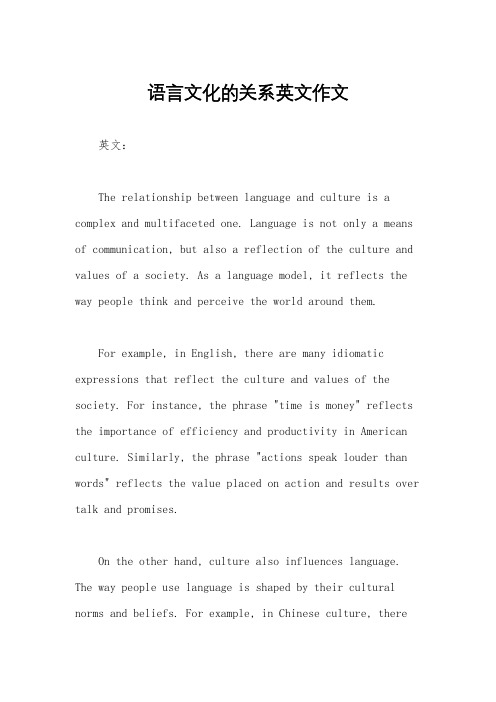英语语言与文化
语言与文化的关系800字英语作文

语言与文化的关系800字英语作文Language and Culture: A Symbiotic Interdependence.Language, the intricate tapestry of words and grammar, serves as the bedrock of human communication. It is through language that we express our thoughts, emotions, and experiences, shaping our perceptions of the world around us. However, language is not merely a tool for conveying information; it is inextricably intertwined with culture, the complex web of traditions, beliefs, and practices that define a society.The symbiotic relationship between language and culture is undeniable. Language is a product of culture, reflecting the values, norms, and worldview of a particular group. The words we use, the phrases we construct, and the stories we tell all carry the imprint of our cultural heritage.For instance, in the Navajo language, there are nowords for "left" or "right." Instead, speakers use termssuch as "east" and "west," reflecting the tribe'straditional orientation to the cardinal directions. Similarly, the Inuit language has a vast vocabulary describing different types of ice and snow, a testament to their profound understanding of their Arctic environment.Conversely, language also shapes culture. By providing the means to articulate beliefs, values, and norms, language influences the way individuals think, feel, and behave. The vocabulary we possess, the stories we share, and the conversations we engage in all contribute to our understanding of ourselves and the world.Take, for example, the concept of "ubuntu" in the Zulu language. Ubuntu refers to a profound sense of interconnectedness and humanity, encapsulating values of empathy, compassion, and social responsibility. Through the use of this term, the Zulu culture promotes a harmonious and supportive community.The interdependence between language and culture is further evident in the phenomenon of linguistic relativity.The Sapir-Whorf hypothesis suggests that the structure of a language influences the way its speakers perceive reality. Languages that lack certain grammatical features, such as the past tense in Hopi, may lead to different cognitive processes in time perception.Moreover, language serves as a repository of cultural knowledge and traditions. Oral histories, legends, proverbs, and folktales are passed down through generations, preserving the collective memory and wisdom of a people.The transmission of this cultural heritage through language ensures its continuity and vitality.In conclusion, language and culture are two sides ofthe same coin. They are inextricably intertwined, mutually reinforcing and shaping one another. Language is areflection of culture, providing a window into the beliefs, values, and practices of a particular group. Conversely, language also plays a pivotal role in shaping culture, influencing the way individuals think, feel, and behave. By recognizing and appreciating this symbiotic relationship,we can gain a deeper understanding of ourselves, ourcultures, and the diverse ways in which we communicate and connect with the world.。
英语教学要注重语言和文化的关系

一
们认为 , “ 弟院校”对应 的英 兄
语 就 应 该 是 “ rhr shos , bo e t col”
、
因为 兄 弟 一词 在 汉 语 中 只有 一 种 意 义 , 但 实 际 上 应 该 是 “ ie st sr sh l ,还 有 他 们 把 “ 眼 病 ” co s ” 红
供 了学 习该 民 族 的语 言 的 基础 。 ” 二 、 中 西 文 化 的 偶 合 现 象 与 文化 差 异 不 同 民 族 的 文 化 有 可 能 存 在 某 些相 同或相似 的地 方 ,这被称 “ 固形 忘 义 ” 是 汉 语 的 特 点 ,也 就 是 “ ” 对 “ ” 的 制 约 很 形 义 大 。 正 因 为 如 此 , 中 国 的 语 言 学 习 者 在 用 英语 表 达 时 被 汉 语 思 维 影 响 滥 用 类 比 ,常 常 犯 错 误 ,他
言 作 为 在 文 化 中最 积极 、最 活 跃
1 . 方 人 之 间 ,如 没 有 血 2西 缘 关 系 ,对 男 子 统 称 呼 “ r , M ”
对 未 婚 女 士统 称 “ i ” Ms ,对 已 婚 s 女士统称 “ s 。但我 们 “ nl Mr” uc e wn ” 也 频频 出现 在 英语 表达 中 , ag 但 实 际 上 这 是 汉 语 思 维 中 的 又 一 类 比现 象 。汉 语 中 的 亲 属 称 谓 有 泛 化 使 用 的倾 向 ,常 用 于 非 亲 属 之 间 :年 轻 人 对 长 辈称 “ 叔 ” 叔 、 “ 姨 ”,对 平 辈 称 “ 哥 ”、 阿 大
这些符号所承载 的约定俗 成的东 西 ,并 在 语 言 交 流 时 在 特 定 的 语 言环 境 内 实施 。英 语 学 习对 于 国
请用英语论述语言与文化的关系作文

请用英语论述语言与文化的关系作文全文共6篇示例,供读者参考篇1The Link Between Language and CultureHi there! My name is Emma, and I'm going to tell you all about how language and culture are connected. It's a pretty neat topic if you ask me. Language and culture go together like peanut butter and jelly!First off, what even is culture? Culture is the way people live, what they believe in, the foods they eat, the clothes they wear, the music they listen to, and all the traditions they follow. Every group of people has its own unique culture. That's what makes the world such an interesting and diverse place!Now, language is a big part of culture. The words we use, the way we say things, it all comes from the culture we grow up in. Let me give you an example. In English, we say "cheese" when we take a picture. But in Spanish, they say "whiskey!" Isn't that funny? It's because "whiskey" kind of sounds like the Spanish word for cheese, which is "queso."Language also reflects the values and beliefs of a culture. Like, in some cultures, they have different ways of addressing elders or people in authority to show respect. In English, we might call our grandparents "Grandma and Grandpa," but in other languages, they might use special titles or honorifics.Another way language and culture are linked is through idioms and expressions. Idioms are phrases that mean something different from the literal meanings of the words. For instance, in English, we might say "It's raining cats and dogs" to mean it's raining really hard. But in other languages, they might use a completely different expression for the same idea.Imagine if you grew up speaking a language and practicing the culture associated with it, and then you moved to a new country with a different language and culture. It would probably feel pretty strange and confusing at first! That's because your language and culture are so deeply connected to who you are and how you see the world.There are also some cultures that have more than one language. Like in Switzerland, they speak German, French, Italian, and Romansh. And in India, they speak hundreds of different languages! But even within the same country, the differentlanguage groups often have their own unique cultural traditions and practices.Sometimes, when two cultures come together, their languages can influence each other too. This is called language borrowing. For example, the English word "algebra" actually comes from Arabic, and the Spanish word "nacho" comes from the name of a Mexican guy named Nacho who invented the dish!Preserving languages is important for preserving cultures too. When a language dies out, a part of that culture's identity and history can be lost forever. That's why there are efforts to revive endangered languages and keep them alive.Okay, I could go on and on about this topic, but I think you get the idea. Language and culture are like two peas in a pod –you can't really have one without the other. The way we communicate through language is shaped by our cultural backgrounds, and our cultures are expressed and passed down through language.So the next time you learn a new word or phrase in another language, think about what it might reveal about the culture it comes from. And remember, learning about different languages and cultures is a great way to expand your understanding of the world and the people in it.That's all from me, folks! I hope you found this essay informative and maybe even a little bit fun. Let me know if you have any other questions about language and culture. I'm always happy to chat more about this fascinating topic!篇2Certainly! Here is an essay of around 2000 words, written in an elementary school student's tone, discussing the relationship between language and culture in English.The Magic of Words and TraditionsHi there! Have you ever wondered why people from different parts of the world speak different languages? Or why they have different customs and celebrations? Well, let me tell you all about the fascinating connection between language and culture!Language is more than just a bunch of words we use to communicate. It's like a magical key that unlocks the door to a whole new world – a world filled with unique beliefs, traditions, and ways of life. You see, every language is deeply rooted in the culture it comes from, and every culture has its own language that helps it grow and thrive.Let me give you an example. Imagine you're visiting a friend's house, and their family is celebrating a special occasion. You might see them wearing traditional clothes, eating delicious foods you've never tried before, and even participating in funny-looking dances or rituals. At first, it might seem a little strange, but that's just because it's different from what you're used to!But here's the cool part: the words they use to describe these traditions and celebrations are just as special and unique as the traditions themselves. They might have words in their language that don't even exist in yours because those words describe things that are specific to their culture. Isn't that amazing?It's like having a secret code that only people from that culture can fully understand. And the more you learn about their language, the more you'll understand about their culture, too!But it doesn't just work one way. Culture also shapes language in incredible ways. Think about all the sayings and expressions we use in our everyday conversations. Many of them come from our cultural beliefs, stories, and even the way we see the world.For example, in English, we say "it's raining cats and dogs" when it's raining really hard. That's because, in our culture, wehave a lot of funny sayings and stories involving animals. But in other cultures, they might use completely different expressions to describe heavy rain, based on their own traditions and beliefs.And that's not all! Even the way we pronounce certain words or the way we structure our sentences can be influenced by our cultural backgrounds. It's like our language is a mirror that reflects the rich tapestry of our customs, values, and histories.But don't worry, you don't have to be a language expert or a cultural scientist to appreciate this amazing connection. All you need to do is keep an open mind and be curious about the world around you.Whenever you meet someone from a different culture, ask them about their language and their traditions. You might be surprised to learn that the way they say "hello" or the way they celebrate a birthday is completely different from what you're used to. And who knows, you might even pick up a few new words or expressions along the way!So, the next time you hear someone speaking a language you don't understand, or you see them practicing a tradition that seems unfamiliar, don't be afraid to ask questions and learn more about it. Because every language and every culture has afascinating story to tell, and the more we understand each other, the more we can appreciate the incredible diversity of our world.And who knows, maybe one day you'll be the one teaching others about your own language and culture, and how they're both part of the same magical adventure we call life!篇3The Connections Between Language and CultureHi there! My name is Jamie and I'm going to tell you all about how language and culture are connected. It's a really interesting topic that I've been learning about in school.First, let me explain what language and culture mean. Language is the way we communicate with words, either by speaking, writing, or using sign language. Every country and group of people has their own language or languages that they use. Culture is all the beliefs, values, traditions, behaviors, and ways of life that are shared by a particular group of people. It includes things like their holidays, food, music, art, and more.Now, you might be wondering how language and culture are related. Well, they are actually super closely linked! The language that people speak impacts and shapes their culture. At the sametime, the culture of a group influences the language they use. It's like they go hand-in-hand and affect each other.Let me give you some examples to help explain. Different languages have certain words that don't exist in other languages because those words represent ideas, objects or traditions that are unique to a particular culture. Like in the indigenous language of Hawaii, there is a word "ohana" which refers to their concept of family being extended beyond just parents and siblings. It includes neighbours, close friends and other loved ones. Because this idea of an extended family is so important in Hawaiian culture, they have a special word for it in their language.Another example is how some languages have different ways to refer to people based on their age, status or gender to show respect. This reflects cultural values around hierarchy and manners. In Korean, there are specific honourifics and different verb forms you use with elders, teachers or your boss to be polite. But more casual language is fine with your peers. Their language encodes those cultural beliefs about showing deference.Food terms are another area where you can really see the culture-language connection. Cultures with particular signature dishes or ingredients will have very specific words for them intheir language. Like the French have around 400 words just relating to cheese because it's such a huge part of their cuisine and culture! Or how there are over 200 words for camels and their behaviors in Somali since camels are central to their nomadic way of life.Sometimes the words and metaphors we use can give insights into a culture's core values too. Expressions involving time reflect whether a culture has a more linear, future-oriented view or a cyclical, tradition-focused perspective. Languages also encode cultural attitudes towards concepts like individuality versus community, humanity's relationship with nature, and much more.Beyond vocabulary, even the grammatical structures and rules of a language can be shaped by cultural influences. Some languages' grammars emphasize hierarchical relationships more through complex systems of honourifics and formalities. While others place more value on egalitarian principles with simpler grammars that don't encode feudal-style hierarchies as much.Overall, you can see that language and culture have this amazing, intertwined relationship where they constantly influence each other. The culture impacts the language through imported words, metaphors, and structures. And in turn, thelanguage shapes the culture by highlighting certain ideas and viewpoints that then become central to that group's shared experiences and values. They really can't be fully separated.I find this topic so fascinating because it shows how language isn't just a neutral tool for communication. The words and grammar we use are imbued with deeper cultural meanings, assumptions and ways of thinking about the world. By learning about the language-culture connections, we can better understand different societies and appreciate the diversity of human experience and knowledge systems.Language is powerful - it doesn't just describe reality, it also plays a role in constructing our understanding of that reality. That's why preserving linguistic diversity is so important, since each language captures unique cultural wisdoms and perspectives that could be lost if those languages go extinct.Hopefully this has helped explain the deep, interwoven relationship between language and culture! Even though the details can seem quite complex, the core idea is simple - the words we speak don't exist in isolation, but carry with them entire worldviews, value systems and cultural DNA. The next time you're learning a new language, pay attention to those hidden cultural meanings too. There's a whole world of fascinatingconnections to explore between how people communicate and how they see the world around them.篇4The Connection between Language and CultureHave you ever thought about how the language you speak is related to your culture? Language and culture are like two sides of the same coin – they are closely connected and influence each other in many ways. Let me explain what I mean.Languages are more than just words and grammar rules. Each language carries its own unique way of thinking, expressing ideas, and viewing the world. The words we use, the way we structure sentences, and even the sounds we make all reflect the culture and history of the people who speak that language.For example, in English, we have many words that come from other languages like French, Spanish, and German. These words were introduced into English through cultural exchanges, trade, and migrations of people. The word "croissant" comes from French, and it reflects the influence of French culture on English-speaking countries. Similarly, words like "taco" and "fiesta" come from Spanish and reflect the influence of Spanish-speaking cultures.Languages also reflect the values, beliefs, and customs of their speakers. In some languages, there are specific words or expressions that don't exist in other languages because they represent unique cultural concepts. For instance, in Japanese, there is a word "omoshiroi" which means something is interesting or enjoyable, but it also carries a sense of appreciation and respect for the experience. This word reflects the Japanese cultural values of finding joy in simple things and appreciating beauty in everyday life.Different languages can also have different ways of addressing people based on their age, social status, or relationship. In many Asian languages, like Korean and Japanese, there are special honorific forms of speech used when talking to elders or people of higher social status. This reflects the cultural emphasis on respect for authority and hierarchical relationships in these societies.The way we communicate through language is also shaped by our cultural norms and expectations. In some cultures, it is considered polite to maintain eye contact during a conversation, while in others, direct eye contact is seen as rude or disrespectful. Similarly, the amount of personal space people prefer duringconversations, the use of gestures, and the volume and tone of voice can all be influenced by cultural factors.Just as language reflects culture, culture can also shape and influence the evolution of language over time. As societies change, new words and expressions are introduced into languages to describe new concepts, technologies, or social phenomena. For example, with the rise of the internet and social media, words like "selfie," "tweet," and "hashtag" have become part of our everyday vocabulary, reflecting the cultural impact of these technologies.Moreover, language can play a crucial role in preserving and transmitting cultural traditions, stories, and histories from one generation to the next. Many indigenous cultures around the world have rich oral traditions, where stories, myths, and legends are passed down through language. The loss of a language can also mean the loss of valuable cultural knowledge and identity.In conclusion, language and culture are deeply intertwined. Language reflects the unique cultural perspectives, values, and ways of life of its speakers, while culture shapes and influences the evolution of language over time. By learning and appreciating different languages, we can gain a deeperunderstanding and respect for the diverse cultures that exist in our world.篇5Certainly! Here's an essay of around 2000 words on the relationship between language and culture, written in English from the perspective of an elementary school student.The Link Between Language and CultureHave you ever wondered why people from different parts of the world speak different languages? Or why some words and phrases sound strange or funny to you? Well, the reason is that language is closely tied to culture, and they both influence each other in many ways.Let me explain what I mean by using some examples. Imagine you're learning a new language, like Spanish or Chinese. You'll quickly notice that some words or expressions don't make sense when you translate them directly into English. That's because those words or phrases are connected to the culture and traditions of the people who speak that language.For instance, in Spanish, they say "¿Cómo estás?" which means "How are you?" But if you translate it word-for-word intoEnglish, it would be "How are you standing?" That sounds a bit odd, doesn't it? But in Spanish culture, it's just a polite way of asking how someone is doing.Similarly, in Chinese, they have a phrase that translates to "Have you eaten rice yet?" which is a way of saying "Hello" or "How are you doing?" This phrase comes from the importance of rice in Chinese culture and the idea that ensuring someone has eaten is a way of showing care and concern.These examples show how language reflects the values, beliefs, and practices of a particular culture. The words and expressions we use are not just random combinations of letters and sounds; they carry deeper meanings and histories that are tied to the way people in that culture live and think.But it's not just words and phrases that connect language and culture. The way we communicate and interact with others is also shaped by our cultural backgrounds. For example, in some cultures, it's considered rude to interrupt someone while they're speaking, while in others, it's seen as a sign of engagement and interest.Similarly, the way we use body language, gestures, and facial expressions can vary greatly across cultures. In some cultures,maintaining eye contact is seen as respectful, while in others, it's considered impolite or even confrontational.Language and culture are also intertwined when it comes to storytelling, literature, and the arts. The stories, poems, and songs that are passed down from generation to generation often reflect the values, traditions, and beliefs of a particular culture. They use language in ways that are meaningful and relatable to the people of that culture.For example, in many Native American cultures, stories and legends are used to teach important lessons about respecting nature, honoring ancestors, and maintaining a balance between humans and the natural world. These stories are told using specific language, metaphors, and imagery that resonate with the cultural beliefs and experiences of the people.Similarly, in African cultures, oral traditions and storytelling play a significant role in preserving history, passing down wisdom, and celebrating cultural identity. The language used in these stories is rich with proverbs, riddles, and figurative expressions that convey deeper meanings and cultural values.Learning a new language can also give you insights into the culture it's connected to. When you study a language, you learn about the customs, traditions, and ways of life of the people whospeak it. This can help you understand and appreciate different cultures better, and even develop a deeper respect and understanding for people from diverse backgrounds.For instance, when you learn Spanish, you might learn about the importance of family, hospitality, and celebrations in many Spanish-speaking cultures. When you learn French, you might learn about the cultural significance of food, art, and fashion in French society.In conclusion, language and culture are deeply intertwined. The words and expressions we use, the way we communicate, and the stories and traditions we pass down are all influenced by our cultural backgrounds. Learning a new language can open up a window into different cultures and help us develop a greater understanding and respect for the diversity of human experiences. So, the next time you encounter a word or phrase that seems strange or confusing, remember that it's likely connected to a deeper cultural meaning and history.篇6The Connections Between Language and CultureHi everyone! My name is Emily and I'm going to talk to you today about languages and cultures. Have you ever thoughtabout how the language you speak is connected to your culture? It's really interesting to learn about!Every culture around the world has its own language or languages that developed over many years. The words, grammar, sayings and way of speaking in a language grew out of the beliefs, traditions, environment and experiences of that cultural group. So in a way, a language captures the culture's view of the world.For example, some languages have lots of words for different types of snow, while others might have more words about the desert or the ocean depending on where those people lived. The Inuit people who live in the Arctic regions have dozens of words in their language for the different types of snow and ice because it's such an important part of their environment and lifestyle. They need a way to describe the snowy world around them very precisely.Or think about how we say "It's raining cats and dogs" in English when there is heavy rain. That's a funny expression that doesn't make much sense if you think about it literally! But it reflects how English has developed lots of colorful idioms and sayings over time as part of the culture. Other languages willhave their own unique expressions that might not translate directly.The way people speak and the exact words they use can give you clues about their culture and heritage. If you hear someone use certain phrases or talk about particular cultural traditions, you can start to guess where they or their family is originally from. The language holds secrets about their background.When I was younger, I remember struggling a bit with my grandparents' accents when they spoke English. I realized later that was because the way they pronounced certain words was influenced by the Native American language of their tribe. Their accents reflected that cultural heritage carried through the generations, even as they learned to speak English too.Languages and cultures don't just influence each other's vocabulary and pronunciation over time - they can also share fundamental thought patterns and views of the world. The grammatical structures and rules of a language can reveal how its speakers typically organize their thoughts and see the world around them.For instance, some languages assign gender to every noun by calling it "she" or "he" - even for objects like keys or tables! That could suggest those cultures perceive everything as havingmasculine or feminine traits in a way English doesn't. Other languages have a different concept of time built into the grammar, describing events as ongoing or already completed differently than we do in English. So the core structure of a language can shape its speakers' perspective.When children learn a language from birth, they start seeing the world through the patterns and mindsets embedded in that language's system. That cultural view gets passed down from parents and communities as an integral part of how the language is spoken and understood. Fascinating, right?Of course there are exceptions to these generalizations, and language and culture don't match up perfectly for every individual. But in broad terms, the languages and cultures of communities around the globe have grown togetherhand-in-hand over centuries. They have influenced and reinforced each other through shared philosophies, experiences, traditions and environments.That's why languages can be so difficult to translate between - you often can't find a perfect word-for-word match because the deeper cultural context is different. And it's also why learning a new language can give you a window into understanding how other cultural groups view the world in their own unique way.Pretty interesting stuff, isn't it? Languages and cultures are kind of like two tightly woven strands of yarn that make up the tapestry of human diversity on this planet. I find it amazing how the evolution of spoken and written communication has been shaped by cultural influences for every society, and vice versa! Let me know if you have any other thoughts on this topic.。
浅谈英语教学中语言与文化的关系

浅谈英语教学中语言与文化的关系文化语言学研究表明,语言中储存了一个民族所有的社会生活经验,反映了该民族文化的全部特征。
儿童在习得一种民族语言的同时,也在习得该民族的文化。
所以,语言和语言的应用不可能脱离文化而单独存在。
不了解语言中的社会文化,谁也无法真正掌握语言。
英语学习的目的是为了准确流畅地表达自己的观点,与人进行交流,然而仅仅靠掌握语言纯正的发音,大量的词汇和准确无误的语法知识,而不对其文化和习俗做深入的了解就往往会令人啼笑皆非,产生许多误解。
因而语言教学不能仅仅拘泥于学生听说读写的训练,而应在教学的一开始就与社会生活紧密联系,尤其在英语语言的初级阶段,让语言和文化既讲形式更重内容。
那么,英语应怎样才能搞好语言和文化的教学呢?语言教学中的文化教学并不是深不可测的难点。
日常口语交际中就存在着众多文化因素,各类教材也提供了大量真实的语言素材,教师可以充分加以利用和发掘。
文化因素存在于最简单的交际活动中,文化教学也应存在于最基本的日常教学中。
经过多年的教学实践,我认为主要可以从以下几方面做起:一、英语教师必须不断提高自身的文化修养文化背景知识包罗万象,从广义上讲,它包括所学外语国家的政治、经济、历史、地理、文艺、宗教、习俗、礼仪、道德、伦理、心理及社会生活的各个方面;从狭义上讲,语言是文化的重要载体之一,如:日常用语、专有名词、成语典故、民间谚语等和形体表情等无声语言,都能够反映出大量的文化背景知识。
我们可以通过结交外国朋友,涉猎各种形式的文学作品,观赏精彩的外国电影录像,欣赏格调高雅的外文歌曲等各种渠道来了解外国文化。
作为一名外语教师,必须不断学习,不断提高自身的文化修养,只有这样才能把英语教得意趣横生。
二、语言教学与文化背景知识教学应同时并举、紧密结合后者要为前者服务,而不是取而代之。
因此,在进行文化背景知识教学时必须优先考虑外语教学的实践性和交际性原则,做到精讲多练,形象生动。
例如:要学生们知道在街道上或商店里看见外国人就问:"Hello!Where do you come from?Whats your name?How old are you?(你从哪里来,你叫什么,你多大了?)"是不礼貌的。
语言文化的关系英文作文

语言文化的关系英文作文英文:The relationship between language and culture is a complex and multifaceted one. Language is not only a means of communication, but also a reflection of the culture and values of a society. As a language model, it reflects the way people think and perceive the world around them.For example, in English, there are many idiomatic expressions that reflect the culture and values of the society. For instance, the phrase "time is money" reflects the importance of efficiency and productivity in American culture. Similarly, the phrase "actions speak louder than words" reflects the value placed on action and results over talk and promises.On the other hand, culture also influences language. The way people use language is shaped by their cultural norms and beliefs. For example, in Chinese culture, thereis a strong emphasis on politeness and respect for authority. This is reflected in the use of honorifics and formal language in Chinese communication.In addition, language also plays a role in shaping and reinforcing cultural stereotypes and biases. For example, the use of derogatory terms for certain groups of people can perpetuate negative attitudes and beliefs about those groups.Overall, the relationship between language and culture is a complex and dynamic one. Language reflects and reinforces cultural norms and values, while culture shapes the way language is used and perceived.中文:语言和文化之间的关系是一个复杂而多方面的问题。
浅谈初中英语语言与文化的关系

浅谈初中英语语言与文化的关系初中英语语言与文化有着紧密的关系。
语言是人类文化的重要组成部分,它不仅是人们交流的工具,也是传递文化的媒介。
而英语作为一种世界性语言,在全球范围内流行,其语言和文化之间的关系更加显著。
首先,语言是文化的载体。
英语作为一种语言,把表达思想和交流信息的功能赋予了文化传递。
通过英语的使用,人们可以传递和传承自己的文化,使别国人了解自己的文化。
例如,英语中存在大量的词汇和表达方式与英国文化相关,如"tea"、"queen"、"shakespeare"等,这些词汇和表达方式都是英国文化的代表。
通过学习英语,初中生能够了解和体验不同文化的魅力。
其次,语言反映了文化的特点。
每个国家和地区的文化都有其特色和独特的价值观念,而语言正是这些特色文化的反映。
例如,英语中存在许多与习俗和价值观念相关的表达方式,如"merry christmas"、"good luck"、"thank you"等,这些表达方式展示了西方文化中的圣诞节、好运和感激之情。
通过学习英语,初中生可以了解不同文化的特色和习俗,培养跨文化交流的意识和能力。
此外,语言塑造了人们的思维方式和行为方式,从而影响文化。
英语国家的人们通常会使用英语思考、表达和交流,这种思维方式与行为方式渗透到他们的日常生活中,形成了一种独特的文化。
比如,英语中的礼貌用语和交际方式非常重要,人们注重言辞的尊重与友善,这反映了英语文化中强调的礼仪和文雅。
通过学习英语,初中生可以培养出与他人友好交往的良好品质,提高自己的人际交往能力。
最后,语言和文化之间是相互影响和相互促进的关系。
语言是文化的表现形式,同时文化也塑造了语言的形成和发展。
例如,英语中的词汇和语法结构受到英国文化的影响,它们在漫长的语言发展过程中被赋予了特定的文化内涵。
而随着语言的发展和演变,文化也在不断地变化和发展。
英语语言与文化传播对英语教学的启示

英语语言与文化传播对英语教学的启示随着全球化的发展,英语已经成为了全球最重要的国际交流语言之一、在英语作为一门外语教学中,语言与文化传播扮演着非常重要的角色。
英语语言与文化传播对英语教学的启示主要有以下几点:首先,文化的传播能够增强学习者的学习兴趣和动机。
在学习一门外语的过程中,语言是载体,文化是灵魂。
只有了解和理解背后的文化内涵,学习者才能真正感受到语言的魅力,激发学习兴趣和动机。
因此,在英语教学中,要将语言与文化相结合,通过文化知识的传授,引导学习者对英语学习的兴趣和热情。
其次,语言和文化是相互关联的。
语言是文化的一个重要组成部分,反过来,文化也对语言产生着深远的影响。
在英语教学中,要注重培养学习者的跨文化交际能力,让学习者不仅仅学会语言的表面知识,还能够理解语言背后的文化差异和习惯。
通过培养学习者的跨文化交际能力,帮助他们适应国际交流的需求,提高英语实际运用能力。
第三,文化的传播能够帮助学习者提高英语语言能力。
通过学习文化,学习者可以拓宽词汇量,丰富语法结构,提高语言的应用能力。
比如,在学习英语习语和成语的时候,学习者需要了解其中的文化含义,掌握其正确的用法。
通过学习文化,学习者能够更好地理解和运用语言,提高英语语言能力。
最后,英语语言和文化的传播是相互促进的。
英语作为世界主要的国际交流语言之一,其文化也随之传播到了世界的每个角落。
学习英语的人通过学习语言,也能够更好地了解和接受英语文化。
在英语教学中,要充分利用英语语言和文化的传播优势,引导学习者更深入地了解和领会英语文化,从而更好地应对国际交流的需求。
总之,英语语言与文化传播对英语教学有着重要的启示。
在英语教学中,要将语言与文化相结合,通过文化的传播,激发学习者的学习兴趣和动机。
同时,培养学习者的跨文化交际能力,提高实际运用能力。
通过学习文化,提高语言能力。
最终,通过英语语言和文化的传播,帮助学习者更好地了解和接受英语文化,提高国际交流的能力。
英语语言文化的体现与研究

英语语言文化的体现与研究英语作为一门全球通用的语言,在国际交流、文化传播方面发挥着巨大的作用。
然而,对于非英语国家的人来说,学习英语并不仅仅是学习一种语言,更是了解和融入英语文化的一种方式。
本文将通过对英语语言文化的体现与研究,探索英语语言和文化之间的紧密关系。
一、英语语言中的文化隐喻语言是一种文化符号,表达着人们对世界和人生的认识、理解和感受。
英语语言中的文化隐喻体现了英语文化的独特性和丰富性。
例如,常用的“break a leg”这一表达在英语世界中表示祝福和成功,而在其他文化中可能没有类似的表达。
同样的,如果你在英语世界中听到某人说“I’m as cool as a cucumber”,那么你就能够了解到这个人非常镇定冷静。
除了以上的例子以外,英语语言中还存在着许多关于颜色、动物、习俗、神话等方面的隐喻。
这些隐喻在英语文化中常见,但在其他文化中可能没有或诠释不同。
因此,在学习英语语言的同时,了解英语文化的隐喻也是非常重要的。
二、英语语境和文化背景英语语言与英语文化之间的联系并不局限于文化隐喻。
它们之间的关系还体现在了英语语境和文化背景当中。
在英语交流中,人们经常使用一些特定的词汇、词语、句子结构和语调,这些都是建立在英语文化背景之上的。
比如,当我们听到一句“Just do it”,我们自然会想到耐克公司的广告语,因为这是一个嵌入了英语文化的流行语。
同样的,英语中的一些词汇和短语在具体的英语文化和语境中也可能有不同的含义。
如英语中的“tea time”虽然字面意思是“下午茶时间”,但在英国文化中则有更为宽泛的含义,也是英国人与家人、朋友和同事交流的重要时刻。
因此,要想真正掌握英语语言,我们不仅需要学会语法、词汇和发音,更需要了解英语文化和语境,并学会在不同的情境中运用语言。
三、英语文化的影响语言和文化之间是相互影响的关系。
英语作为一种全球通用的语言,其语言和文化还在不断地影响着其他文化和语言。
论英语教学中语言与文化的关系(一)

论英语教学中语言与文化的关系(一)
论英语教学中语言与文化的关系
1. 语言作为文化的载体
•语言是一种文化的表达方式
•语言反映了不同文化背景下的观念、价值观和习俗•通过语言学习可以了解和体验其他文化
2. 语言与文化的相互影响关系
•语言和文化相互作用,互为因果关系
•文化影响语言的使用方式、词汇和语法结构
•语言也会影响文化的传承和演变
3. 语言在文化学习中的作用
•学习语言是了解和适应目标文化的重要途径
•通过学习语言可以体验其他文化的思维方式和生活方式•语言学习培养跨文化沟通和理解的能力
4. 文化背景在英语教学中的重要性
•英语教学应注重培养学生的跨文化意识和能力
•教师应融入文化背景的教学内容,提供文化参考和背景知识•学生应学习并尊重不同文化的差异和多样性
5. 语言与文化教学的现实挑战
•教师需要具备深厚的语言和文化知识
•学生需积极参与文化学习,与语言学习相辅相成
•跨文化沟通中的误解和冲突需要及时解决
6. 总结
•语言和文化密不可分,相互影响和作用
•语言学习应注重文化的了解与体验
•英语教学应致力于提高学生的跨文化意识和能力
以上是关于“论英语教学中语言与文化的关系”的简述。
通过这样的文章格式可以清晰地了解语言与文化之间的密切联系,以及在英语教学中如何重视语言和文化的融合。
英语学习中的文化意识

英语学习中的文化意识语言和文化是密不可分的,中西文化既有偶合现象又有文化差异。
在英语学习中要注重语言和文化的关系,了解英语的风土人情,历史地理等社会知识,提高对中西文化差异的认识,树立文化意识并注重文化知识的学习。
英语作为一种交际工具,我们除了应该学习语音,词汇,语法等语言基础知识外,还应该了解与英语国家民族有关的社会文化背景知识,否则就会给语言交际造成很多障碍,甚至会闹出笑话。
在英语教学中要注重语言和文化的关系。
了解英语国家的风土人情,历史地理等社会知识,提高对中西文化差异的认识,树立文化意识并注重文化知识的传授。
一、语言和文化是密不可分的长期以来。
在英语教学中语言和文化的这种关系一直未得到足够的重视。
在教学实践中,似乎认为只要进行听、说、读、写的训练,掌握了语音、词汇和语法规则就能理解英语和用英语进行交际。
而实际上,由于不了解语言的文化背景,不了解中西文化的差异,在英语学习和用英语进行交际中屡屡出现歧义误解的现象。
中国人见面喜欢问对方年龄啊.收入啊等问题来表示对对方的关心。
殊不知在西方人看来这是一句冒犯的问话,侵犯了别人隐私.会激起对方的反感。
中国人以谦逊为美德。
如当外国人称赞中国人某一方面的特长时,中国人通常会用“过奖”来应酬,这往往会让说话者感到你在怀疑他的判断力。
美国社会学家G.R.Tucker和W.E.Lambert对于外语教学中只教语言不教文化有这样的看法:“我们相信.任何这类企图都会使学生失去兴趣,使他们不仅不想学习语言符号本身,而且也不想了解使用这一符号系统的民族。
相反,帮助学生在学习语言时提高对文化的敏感性.就可以利用他们发自内心的想了解其他民族的兴趣和动力。
从而提供了学习该民族的语言的基础。
”二、中西文化既有偶合现象又有文化差异不同民族的文化有可能存在某些相同或相似的地方。
这被称为文化的偶合现象。
这种相似性必然会反映到语言中来。
因而在英语和汉语中.我们不难发现许多相同或相似的表达。
英语教学和语言与文化的关系

英语教学和语言与文化的关系众所周知,语言是文化信息的一种承载,是人类社会生活的工具。
具体的英语教学也应当使语言成为学习科学文化知识,获取社会各方面信息与进行国际交往的工具。
在英语教学中如能打破结构主义框架,重视英语运用能力的培养,了解英语语言与文化的差异和关系,对完善英语教学工作来说,将大有益处。
细心的我们可以发现这样一种现象:语言词汇的文化内涵极为丰富,但在许多方面存在着不对应现象。
从语言学和跨文化交际学的角度看,是因为每一种语言都有它自身特有的语言体系与结构,每一个民族都有它自己的生活习惯、思维方式、价值观念等。
新的《全日制普通高级中学英语教学大纲》(以下简称《大纲》),对于外语教学的交际性原则、语言与文化的关系等做了较为明确的规定。
用教学大纲的形式强调语用能力培养、明确提出认识语言与文化关系的重要性,有着特殊的意义。
但在教学中人们对交际教学法、语言与文化关系却存在模糊认识,认为中学阶段外语教学主要目的应是语言知识的教学;目前中学教学内容相对简单,文化教学无法进行。
但探讨交际性语言教学中,处理好文化与语言关系的必要性和可能非常关键。
具体体现在:一、语言教学中交际性原则的运用及文化教学必要性首先,语言学、语言教学理论的不断发展使人们对语言的本质认识不断加深,提出语言是交际性工具这一功能性观点。
《大纲》指出:“外国语是学习文化科学知识、获取世界各方信息与进行国际交往的重要工具,外语教学的目的是培养在口头上和书面上初步运用英语进行交际的能力。
专家一致认为,交际能力应包括五方面内容:掌握语法知识;运用听说读写四方面的能力;选择与语境相适宜的话语;根据对方的身份、社会场合,说出合乎自己身份的话语;社会文化知识。
文化语言学研究表明,语言中储存了一个民族所有的社会生活经验,反映了该民族文化的全部特征,语言和语言的应用不可能脱离文化而单独存在。
外语教学不仅要介绍知识并进行“四会”技能训练,更应该把这种学习与训练放到文化教学的大背景中进行,最终使学生具有语用能力。
【英语听力】Language and Culture 语言和文化

Language and Culture语言和文化Languages are marvelously complex语言是极其复杂and wonderfully complicated organs of culture:难解的文化工具:they embody the quickest and the most efficientmeans of communicating 它们是最快捷最有效的交流思想的方法within their respective culture.在各文化中。
To learn a foreign language is to learn another culture.学习外语就等于学习另一种文化。
In a words of a poet and philosopher,一位诗人兼哲学家曾经这样说过:"As many languages as one speaks, so many lives one lives.""你懂几种外语,你就过着几种不同的生活。
"A culture and its language are as inseparable as brain and body;文化及其语言正像人脑与人体一样不可分割。
while one is a part of the other,neither can function without the other. 虽然其中一个是另一个的部分,但是失去一部分,另一部分就不能运作。
In learning a foreign language, the best beginning学习外语最好的开始是is with the non- verbal linguistic elements of the language,从这种语言的非语言的语言成分开始,its gestures,its body language.即从手势,体语开始。
英语语言的文化内涵探讨

英语语言的文化内涵探讨英语作为一门国际语言,在全球范围内广泛使用。
它不仅仅是一种工具性的交流工具,还承载了丰富的文化内涵。
本文将探讨英语语言的文化内涵以及它对跨文化交流的影响。
一、英语语言的历史背景英语起源于古代日耳曼部落,并逐渐发展成为现代英语。
在历史的长河中,英语受到了许多外来文化的影响,如古罗马帝国、哥特人、维京人等。
此后,英格兰的殖民活动和英国帝国的崛起也进一步推动了英语的传播。
这些历史背景使得英语拥有了多元的文化内涵。
二、英语语言的词汇特点英语的词汇来源广泛,既包括古代日耳曼语族的词汇,也包括了古希腊、拉丁语以及其他外来语言的借词。
这使得英语具有了丰富多样的词汇特点,不同的词汇背后也有着不同的文化内涵。
例如,英语中的“tea”一词源于中国的“茶”,反映了中国茶文化对英国的影响。
另外,一些习语和俚语也成为了英语中的独特表达方式,如“raining cats and dogs”(下大雨)和“kick the bucket”(去世),这些表达方式反映了英语国家的文化特色。
三、英语语言的语法结构英语的语法结构也反映了其文化内涵。
例如,英语中的人称代词无分你我,以及不区分第二人称单数和复数的情况,这反映了英语文化中平等和社会亲近的价值观。
此外,英语的时态和语态也影响了其文化内涵。
英语的时态较为复杂,不同的时态传递不同的信息。
而英语的语态则强调动作的承受者或执行者,这体现了英语社会对于责任的重视。
四、英语语言的文化传播英语作为一种全球通用语言,其文化价值也得以传播。
英语文学、电影、音乐、艺术等方面的作品通过英语的媒介传播到世界各地,让更多的人了解英语国家的文化内涵。
同时,英语的国际化也导致了英语与其他文化进行交流和交融。
通过学习英语,人们可以更好地了解其他国家和地区的文化,促进了文化多样性的发展。
五、英语语言的跨文化交流英语作为国际语言,其文化内涵对于跨文化交流具有重要意义。
在跨文化交流中,除了语言的表达外,了解对方的文化内涵也尤为重要。
英语语言文化介绍

英语语言文化介绍English Language and Culture Introduction:English is one of the most widely spoken languages in the world, with over 1.5 billion speakers globally. It is an official or widely spoken language in many countries, including the United States, United Kingdom, Australia, Canada, and India. English is also the primary language of communication in various international organizations and industries such as aviation, science, technology, and entertainment.English culture is diverse and rich, influenced by a long history of traditions, literature, arts, and customs. Some notable aspects of English culture include Shakespearean literature, iconic landmarks like Big Ben and Buckingham Palace, traditional afternoon tea, and sports like football and cricket. English culture values politeness, punctuality, and a sense of humor.中文翻译:英语语言文化介绍:英语是世界上使用最广泛的语言之一,全球拥有超过15亿的说英语的人。
英语语言学 第九章 语言与文化

▪ How the Chinese and the Europeans state their age differently. I'm ten and a half years old. The baby girl will be thirteen months old next Friday. Chinese use a round number(整数) followed by the measure sui.
▪ 所有这些类型的意义都与文化编码或联想有关, 因为词语的意义与它们的联想是不可分割的,而 这些联想的解释是约定俗成的。每种语言都有自 己的隐喻,这些隐喻在其范围内提供语义上的理 解。
Some cultural differences in language use
▪ Greetings and terms of address ▪ Gratitude and compliments ▪ Color words ▪ Privacy and taboos ▪ Rounding off numbers ▪ Words and cultural-specific connotations ▪ Cultural-related idioms, proverbs and metaphor
▪ There are generally two types of culture: material and spiritual.
浅谈中学英语教学中语言与文化的关系

浅谈中学英语教学中语言与文化的关系语言与文化是相辅相成的两个概念,它们构成了人类社会的重要组成部分,两者的关系也被认为是直接而密切的。
在中学英语教学中,老师和学生都需要深入理解语言与文化之间的关系。
中学英语课程特别重视语言与文化之间的关系,这不仅体现在中学教材中,而且体现在教学过程当中。
比如,学生可以从教材中学习英语文化,比如英语国家的历史,传统,礼仪,以及与日常生活和传统礼节有关的话题。
老师可以通过举例介绍英语国家的文化,通过辩论,讨论和其他活动让学生探索英语文化,这有助于学生学习语言的同时,也增进了跨文化交流的理解能力。
语言与文化之间的关系也体现在中学英语教学中,当学生学习英语语法和词汇时,可以在文化背景下加以解释和巩固。
学生可以根据英语文化的特点在掌握正确语言形式的同时,也能了解其背后的文化知识。
这将有助于学生更好地理解英语的文化意义,能够更好地运用语言表达英语文化,更加流利地交流。
此外,学习者也可以从语言中了解文化,英语在文化中扮演着重要的角色,每个文化都有其特色,甚至有一定的宗教色彩,词汇中也包含了文化上的特征,也可以用来构建文化知识。
比如,英语中可以体现文化特色的短语,可以帮助学生了解英语文化,比如“No worries”思是“别担心”,这是澳大利亚的文化,学习者在学习的同时可以理解澳大利亚文化的特点。
通过学习英语文化,学生可以更好地了解他们正在学习的语言,同时也可以学习到跨文化交流的礼仪和习俗,从而更好地参与国际交流。
综上所述,中学英语教学中语言与文化之间的关系是不可或缺的,语言是文化的载体,反过来文化也是语言学习过程中探索性学习的重要基础,教师要努力让学生在学习语言的同时,也能够学习文化,让学生形成一句“语文兼修,言语文明”的正确态度。
只有这样,学生们才能够以更好的态度参与国际交流,拓展国际视野,为社会所用。
语言与文化在英语学习中的交融

语言与文化在英语学习中的交融在当今全球化的时代,英语作为一门国际通用语言,其重要性不言而喻。
对于许多学习者来说,掌握英语不仅仅是为了应对考试或者获取某种证书,更是为了能够在跨文化交流中自如地表达自己的想法,理解他人的观点。
然而,要真正学好英语,仅仅掌握语法和词汇是远远不够的,还需要深入了解其背后所蕴含的文化。
语言与文化在英语学习中相互交融,缺一不可。
语言是文化的载体,文化则是语言的内涵。
英语中的词汇、语法、表达方式等都反映了英语国家的文化特点。
例如,“OK”这个简单的单词,在英语国家中被广泛使用,它不仅表示同意、认可,还能传递出一种轻松、随意的态度。
而在一些正式的场合,人们可能会更倾向于使用“affirmative”或者“approved”这样的词汇。
再比如,英语中的习语“break the ice”,直译为“打破冰块”,但其实际意思是“打破冷场,使气氛活跃起来”。
如果不了解这些习语背后的文化背景,就很难准确理解和运用它们。
语法规则也受到文化的影响。
在英语中,时态的使用非常严格,这与英语国家注重时间顺序和逻辑的文化观念有关。
而在一些其他语言中,时态的表达可能没有这么精确。
此外,英语中的被动语态使用较为频繁,这反映了英语国家在表达观点时更强调客观事实,而不是个人主观意愿。
文化对语言的影响还体现在语言的社交礼仪方面。
在英语国家,人们在交流时非常注重礼貌和尊重。
例如,在请求别人帮助时,通常会说“Could you please”而不是“Give me”;在表达不同意见时,会先说一些肯定的话,然后再委婉地提出自己的看法,比如“ I understand yo ur point, but”。
如果不了解这些社交礼仪,即使语法正确,也可能会给人留下不礼貌或者不恰当的印象。
反过来,语言也影响着文化的传承和发展。
通过英语这一语言工具,英语国家的文化得以传播到世界各地。
例如,好莱坞电影、英美流行音乐、英语文学作品等都通过英语向全球观众和读者展示了英语国家的价值观、生活方式和社会现象。
语言和文化的关系英语作文

语言和文化的关系英语作文Language and culture are deeply intertwined with one another. Language is the most primary and important form in which aculture is expressed. The shared language of a culture contains the ideas, values, traditions, and beliefs of the people. Every culture has its own specific language that helps to define its identity. Furthermore, language reflects a culture’s history, helping to tell its story.Language helps to establish and shape the culture in a varietyof ways. It is particularly powerful in the way that it can both limit and expand the way that people think and understand the world around them. Through language, a culture will define its norms, values, and criteria for what is right or wrong, acceptable or unacceptable. Language can also be used to createa sense of belonging and community, as people will share the same language, building a collective identity.At the same time, language is shaped by culture. As a culture changes, its language will evolve to reflect its new ideas and values. Slang, which is a form of informal language, oftenarises as a reflection of the attitudes and interests of a particular group or culture.In conclusion, culture and language have a deep, organicrelationship with one another. A shared language helps to define a culture, while the culture also helps to shape language itself.。
- 1、下载文档前请自行甄别文档内容的完整性,平台不提供额外的编辑、内容补充、找答案等附加服务。
- 2、"仅部分预览"的文档,不可在线预览部分如存在完整性等问题,可反馈申请退款(可完整预览的文档不适用该条件!)。
- 3、如文档侵犯您的权益,请联系客服反馈,我们会尽快为您处理(人工客服工作时间:9:00-18:30)。
英语魅力何在
摘要:英国地理位置优越,历史悠久,其英语的发展也经历大起大落,英语从古英语(450年—1150年)发展到中古英语(1150年—1500年)再发展到现代英语(1500年至今),期间经历凯尔特人的史前文化,文艺复兴,殖民扩张,工业革命等等大事记,而此也使得英语兼容了多国的语言,奠定了它世界第一语言的地位。
英国是海洋民族,它的诸多词汇与海,鱼,船,水手有关,某些词汇语句的词义特别有意思,这便是它魅力所在。
关键字:英国历史;语言发展;英语的兼容性;词义魅力
语言是思维工具和交际工具。
它同思维有密切的联系,是思维的载体和物质外壳以及表现形式。
语言是符号系统,是以语音为物质外壳,以语义为意义内容的,音义结合的词汇建筑材料和语法组织规律的体系。
语言是一种社会现象,是人类最重要的交际工具,是进行思维和传递信息的工具,是人类保存认识成果的载体。
语言是人类的创造,只有人类有真正的语言。
许多动物也能够发出声音来表示自己的感情或者在群体中传递信息但是这都只是一些固定的程式, 不能随机变化。
只有人类才会把无意义的语音按照各种方式组合起来,成为有意义的语素,再把为数众多的语素按照各种方式组合成话语,用无穷变化的形式来表示变化无穷的意义。
现在世界上的已知语言共5651种,公认的独立语言有4200种,其中100万以上的人口使用的由163种。
汉语是使用人数最多的语言,我认为,它是最独特,最美的语言,绝对的无与伦比,其次是英语,是使用范围最广的语言,普及性高。
每位教英语的学者都说,要学好英语,一定要先了解英国的地理和文化,这样才能掌握英语的精髓。
英国位于欧洲,是由大不列颠岛(包括英格兰,苏格兰,威尔士)以及爱尔兰岛东北部的北爱尔兰和一些小岛(海外领域)组成。
英国东
临北海,西、北面对大西洋,南面是英吉利海峡,与法国隔海相望。
本土位于欧洲大陆西北面的不列颠岛,被北海,英吉利海峡,凯尔特海,爱尔兰海和大西洋包围,总面积24.36万平方公里(包括内陆水域),英格兰地区13.04万平方公里,苏格兰7.88万平方公里,威尔士2.08万平方公里,北爱尔兰1.36万平方公里,位于欧洲西部。
政治上,大不列颠岛和北爱尔兰共同组成联合王国,而爱尔兰共和国则是独立联合王国。
我们通常所说的英国,则是指联合王国。
英语语言的魅力来自于它独特的地理条件,英国是海洋民族,许多有趣的单词,语句与海,鱼,船,水手有关,比如Eel(鳗鱼)喻指圆滑,琢磨不定的人,等等,不同的鱼代表不同的人。
而像中国,是内陆民族,许多成语会跟山,湖相关,比如重如泰山等等。
英语语言的魅力还来自于复杂的语言发展过程,英语从古英语(450年—1150年)发展到中古英语(1150年—1500年)再发展到现代英语(1500年至今)。
英语语言的变化主要发生的事记大致是从伊比利亚人开创文明开始,先后经历凯尔特人的史前文化,罗马人的征服,盎格鲁·撒撒克逊的入侵(5世纪),北欧人的侵扰,诺曼底征服(10世纪),乔叟时期,文艺复兴,莎士比亚的作品,《圣经》的翻译,殖民扩张,工业革命,最后到美国英语。
其中,1204年,英王失去了在法国的领地,与法国关系恶化,再加上发往对英国的控制便使得英国人越来越不满,于是出现了“英国人讲英语”的口号,到了英法之间“百年战争1377—1453”时期,英语地位再度提高。
之后,用英语创作的伟大诗人杰弗里·乔叟,官方,法院等开始使用英语,学校开始教授英语。
1362年,英王爱德华三世首次用英语向议会致词。
1382年,约翰·威克里夫把《圣经》拉丁语翻译成英语,这一切终于使英语地位恢复。
英语在经历这些大事记中,兼容了多国的语言,奠定了它使用范围最广的地位,成为世界第一的语言。
一、英语词汇系统的世界性
1、英语属印欧语系的日耳曼语族。
它与荷兰语,德语,瑞典语,丹
麦语,冰岛语,挪威语同属一族,因而英语与这些语言不仅有着赖斯的依法结构,而且有着不少的词语。
2、由于历史的缘故,英语受拉丁语语族影响很深。
据统计,英语的
单词有一般一上源自于拉丁语,有的拉丁语直接输入,有的通过语法途径间接渗进,有的足以从拉丁语词派生而成。
3、英语与拉丁语族的法语、意大利语和葡萄牙语之间相同的单词甚
多,对于日耳曼语或拉丁语族任何一种语言为母语的人而言,英语词汇有许多并非陌生,勿须强记。
统观英语发展史,我们不难发现英语具有吸收外来语的特异功能。
对于这种能力形成的原因说法不一,美国乔治大学语言学院院长认为英语对外来词汇有明显的友好倾向。
在所有源自印欧语系的语言中,“能与关系无论亲近还是疏远的语言保持最亲密联系的是英语”,由于长时期对外来词汇的兼收并蓄,形成了英语词汇的国际性特色,据统计,在英语中外来词的比例高达80%。
二、词形变化的简单性
英语的演变过程是一个语言简化的过程,这段历程中,英语与同语系,同语族的任何语言相比,在简化过程中,所迈的步子更大,英语的简化在系统中。
自然性别代替语法性别:古英语的名词分为阳性,阴性和中性,当时名词的性不仅要知其形,会其音,还要记其性。
三、词形变化的逐渐消失
古英语是一种屈折语,其词汇系统与现今的德语和俄语相似,名词,形容词和代词都有性、数、格词尾的变化。
古英语名词有4个格:主格,所有格,与格和宾格,各个格都有不同的变化形式。
此外,各种变格形式又都与名词的性和数密切相关,因此十分复杂。
四、古英语的形容词有五个格,除主格,所有格,与格和宾格之外还有工具格
形容词又分为强式变格和弱式变格两类,显得非常繁琐,当时的人称代词随人称、性、数而变化形式,加之人称代词不仅有单数复数之分,而且有双数之别,故而变化形式也很繁杂。
五、语言表达的逻辑性
英语动词共有十六种时态,所表达的概念较为细微清晰,法语共有九种时态,德语共有六种时态,俄语共有五种时态。
六、表达形式依据语意
在语意逻辑与语法逻辑发生冲突时,多数情况下英语不受狭隘陈旧的框框束缚。
英语在词义上有很多特别不同于汉语的语句,根据英国的地理文化,大约能猜得出词义是什么。
比如鱼与英语:Whale(鲸)喻指巨大的人或物;Neither fish nor fowl 不伦不类;Drink like a fish 狂饮如鱼,一醉方休。
船与英语:A littile ship needs but o littlie sail.小船配小帆;A small leak will sink a great ship.小洞补填能沉大海;Hoist your sail when the wind is fair.起帆敢风好,莫失良机。
海与英语:A good sailor may mistake in a dark night.好水手也会在夜间出错;A smooth sea never makes a skillful mariner.风平浪静锻炼不出好水手;Being the sea ,sail ,being on the land ,settle.随遇而安。
另外,温带海洋气候给英国带来充沛的降雨,利于花卉植物的生长,他们把各种植物分得很细,比如meadow是湖泊,河流等低洼临水的草地,lawn是人工种植的草地,grassland是草原上的草地,pasture是用于放牧的草地。
还有比如对颜色的看法,中国人结婚喜用红色,表示喜庆,而西方人喜用白色,代表纯洁等等,只有了解了英国的文化,才能更容易发现英语的魅力,英语是一门奇特,有意思的语言,又因为它的兼容性,尽管对以汉语为母语的中国人来说学习起来不容易,但对很多印欧美国家来说,学习起来是很容易的。
参考文献
[1]摘自百度百科./view/9793.htm.
[2]钱乘旦.英国通史.上海社会科学院出版社.2007
[3]丘吉尔. 英语民族史.薛力敏,林林译.南方出版社.2004
[4]朱文俊.现代英语语言与文化研究.北京语言学院出版社.1994
[5]冯世梅.英语词汇学.中国水利水电出版社.2002
[6]平洪,张国杨..英语习语与英美文化.北京外语教学与研究出版社.1998
[7]黄勇.英汉语言文化比较.西北工业大学出版社.2007年3月。
